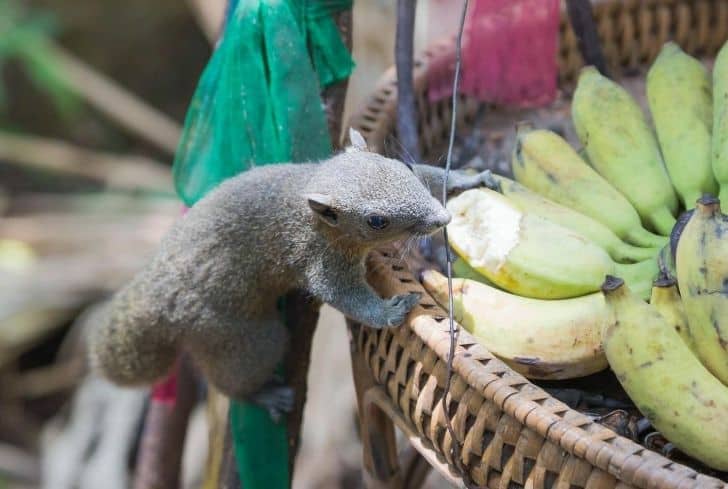13 Amazing Animals With Ringed Tails (With Pictures)

While tailed creatures are a common site in the forests, their counterparts with ringed tails are rare.
Some of these animals with ringed tails are shy and dislike the idea of coexisting with humans. Others live in places where you may never see them unless in nature documentaries. The purpose of the rings is controversial, with some accounts suggesting some animals use them to ward off predators.
To help you get a picture of these unique animals, in this article, we’ll take you on a walk in the jungle so you can know more about them, including where they live.
13 Types of Animals With Ringed Tails
1. Ringtail

Ringtail, also called miner’s cat, is a member of the raccoon family, and it’s found in the deserts of North America. Timid towards humans, ringtails reside in tree hollows and abandoned structures.
The color of the mammal ranges from black to dark brown but is pale on the downsides. It has a pointed muzzle with fox-like whiskers, and you can confuse its face with a mask.
Ringtails have mastered the art of climbing, thanks to their long, black and white ringed tails, which can have up to 16 stripes. While the long tail helps the animal move from branch to branch effortlessly, the rings help to distract predators.
The miner’s cat is a nocturnal animal and is open to all types of food, from rats, lizards, and frogs to fruits, berries, and nuts.
2. Cacomistles

The cacomistle is a timid animal that looks a lot like a cat.
The mammal has white patches on its big eyes, and its body is covered with grey fur with pale underparts. It has a long, black and white tail with rings. The ears of the cacomistle are pointed, and they have masked faces. While you can easily confuse them with the ringtail, Cacomistles are distinguished by their non-retractable claws.
Cacomistles are found in tropical forests and woodlands of Central America and Mexico, but you can also find them in Panama. They like the middle to upper levels of the canopy where they forage and also look for water.
As generalists feeders, these animals can survive on amphibians, insects, small vertebrates, and fruits. What’s more, Cacomistles are nocturnal, and as shy animals, they live far away from human reach, so it’s hard to see them.
3. Ring-tailed Vontsira

The Ring-tailed Vontsira is a long, slender nocturnal mammal with a pointed nose and is closely related to the mongoose. The body adorns dark-red fur, the legs are black, and its bushy tail wears black and red rings.
Native to Madagascar, the Ring-tailed Vontsira are playful creatures that prefer doing their antics in montane forests, tropical, humid lowlands, and deciduous forests. The animals use their ringed tail for balance when climbing through the trees.
As carnivorous animals, Ring-tailed Vontsira eat invertebrates, small mammals, reptiles, fish, and occasionally insects.
4. Red Panda

Also called the lesser panda, the red panda is a small mammal you can easily recognize thanks to its signature ruddy coat color. It has a thick red-brown fur with black underparts and legs, a short snout, and big pointed and white-lined ears on its large, round heads. They also have ringed tails.
Red pandas are residents of Southwestern China and the Eastern Himalayas and prefer temperate forests and high-altitude areas with bamboo trees. Agile climbers, these animals spend about 90% of their time in trees, where they like showing off their exceptional acrobatic skills. But you may never get a chance to see them, as red pandas are shy and reclusive.
Bamboo leaves make up the bulk of their diet, but you can still find fruits and berries on their menu.
However, red pandas are now endangered due to humans hunting down these adorable creatures for their fur and deforestation.
5. Ring-tailed Lemurs
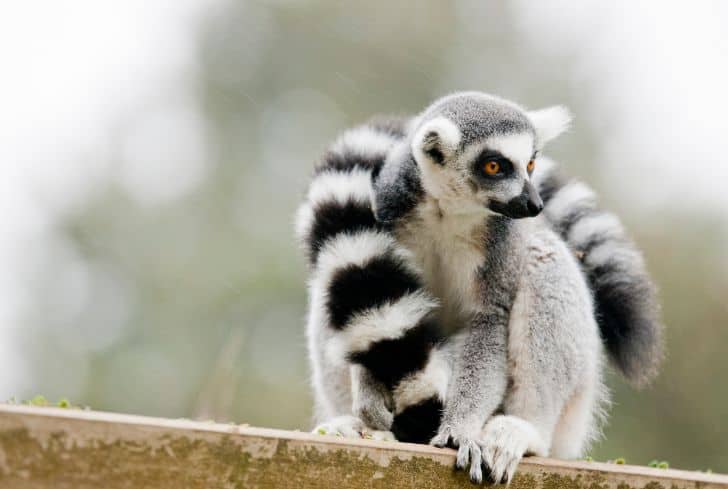
Ring-tailed lemurs are diurnal mammals with colors ranging from rosy brown to gray but white undersides. They also have white faces, dark eyes, and black noses. And living to their name, ring-tailed lemurs have 13 alternating black and white rings on their tails. Researchers suggest that these rings help the animals communicate, as they raise their tail when greeting each other.
Like Ring-tailed Vontsira, these lemurs are native to Madagascar, living in forests and open areas in the southern parts of the island. They spend about 40% of their time on the ground, sunbathing in the open areas of the forest. They are social animals, forming troops of about 30 individuals.
However, deforestation in the Madagascar forest, plus the illegal pet trade, is critically reducing the numbers of ring-tailed lemurs and, subsequently endangering the species.
6. Mexican Raccoon

Also known as Kudamundi, the Mexican Raccoon is a cat-sized mammal with a colorful ‘mask’ on its face and rings around its tail. It belongs to the same family as ring-tailed cats.
Kudamundi is found in most regions of the world, including Central, North, and South America and Brazil, while it also ranges in Mexico, as its name suggests. The animal is a nocturnal creature, preferring to sleep on hollow logs and trees during the daytime.
When foraging at night, their diet consists of nuts, fruits, rodents, and insects. You can also find them in groups of about 40 individuals near water bodies as they are also agile swimmers. They’re also nuisance animals that can raid trash cans and feeders if there’s a farm nearby.
7. North American Raccoon
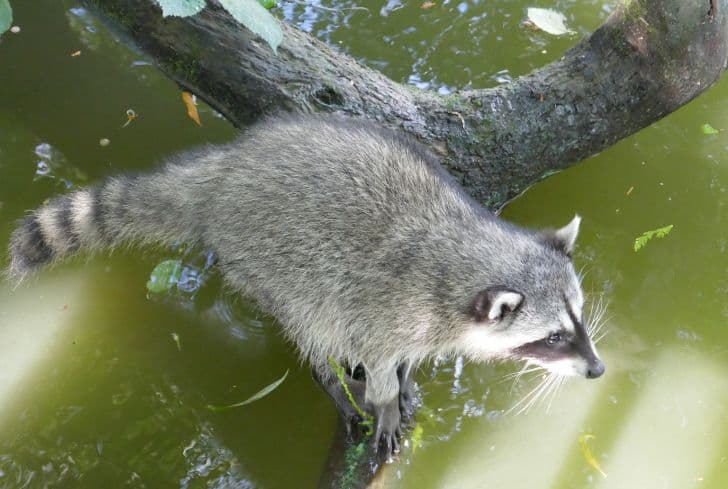
North American Raccoon is a robust animal with a pointed muzzle, short legs, and small ears standing upright. The ringed tail adorns up to 10 black bands.
The animal lives in Canada and Southern America, spending their day sleeping in hollow trees and burrows of other animals in the forests and grasslands of these regions. At night, the North American Raccoon is out and about, exploring the ranges while foraging for rodents, frogs, and fruits.
The animals are not restricted to the forest, as you can often find them in buildings in rural and suburban areas. Here, they look for food everywhere, including garbage and are a nuisance to homeowners with gardens. Curious animals, they investigate anything in their sight and can even break into houses and wreak havoc.
8. South American Coati

Also called ring-tailed coati, South American Coati is a member of the raccoon family with coat colors ranging from brown, grey, red, and white. The elongated snout is dark, and the black tail has visible yellow rings. The tail helps when the Coati is climbing trees while doubling up as a blanket during sleep.
South American Coati is native to South America, living in forests including deciduous rainforests, tropical evergreen rainforests, and dry scrub forests. They prefer climbing to high canopies where they effortlessly get their food in the form of fruits, lizards, larval beetles, and spiders. But they can also walk on the ground.
However, South American Coati is threatened by hunting and deforestation.
9. Cozumel Raccoon

The Cozumel raccoon is a small animal with a body covered by buff-grey fur with pale-buff legs and underparts. It wears a black throat band, and the yellowish tail has about 7 black or brown rings. It’s often called dwarf Raccoon due to its small size.
The animal is restricted to Cozumel Island, inhabiting the sandy wetlands, semi-evergreen forests, and mangrove forests. Researchers have also captured the small animal in agricultural lands near these habitats. As omnivores, fruits, lizards, frogs, and crabs are some of the foods they eat.
However, due to inadequate geographical range, Cozumel raccoons are critically endangered, with not more than 300 animals left.
10. Western Mountain Coati
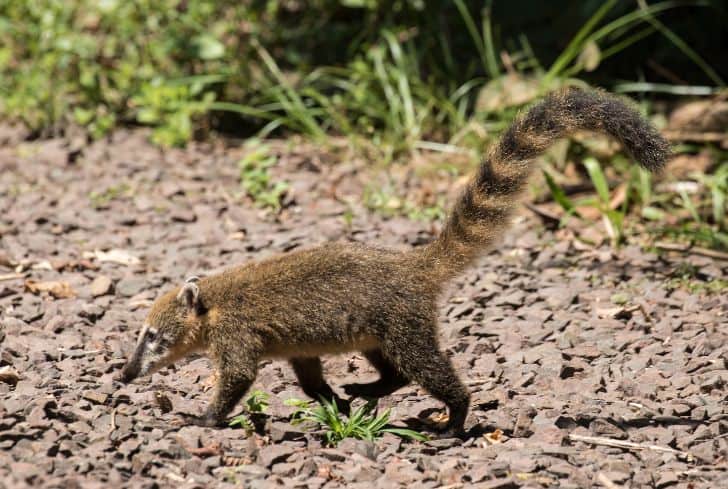
Western mountain coati is a medium-sized animal belonging to the Procyonidae family, which is easier to identify as it’s usually black with less visible rings on its long tail.
Also called the western dwarf coati, the animal prefers high canopied areas of about 1300-4500 meters and inhabits the cloud forests of the Andes in Ecuador and Colombia.
11. White-nosed Coati
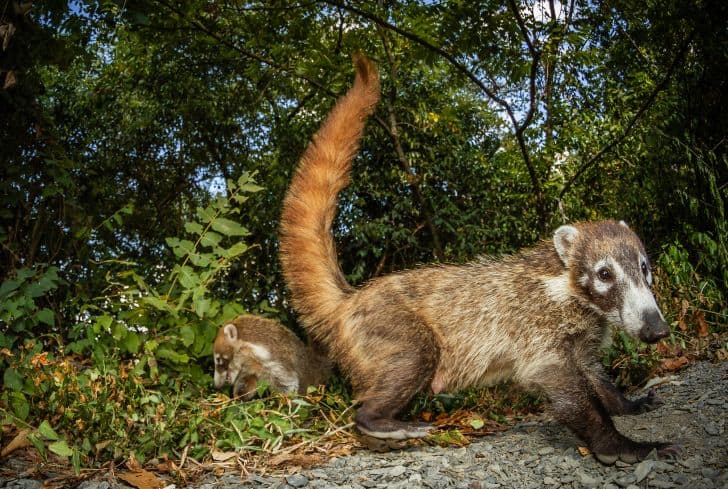
The white-nosed coati is a close relative of Raccoons. It has brown fur with a mixture of yellow and red on the back, while its undersides are lighter yellow. It has a long, thin, ringed tail that it holds upright when roaming around. It’s an agile tree climber, thanks to the long tail.
The animal is found in various countries, including Mexico, Central America, and Columbia. It prefers woody canyons and mountain forests.
When foraging, White-nosed coati usually drops to the ground to look for termites, beetles, ants, insects, snakes, and carrion.
12. Eastern Raccoon

The Eastern Raccoon is a small mammal with a long tail that wears black and white rings.
Not to be confused with the Western Raccoon, this animal is smaller and has a relatively small tail. And while both species are usually black, the Eastern Raccoon has a dorsal stripe on the back.
Eastern Raccoon lives in North America and prefers marshes, prairies, and forests. You can also spot the mammals in cities, particularly near farms and gardens.
In the wild, the nocturnal raccoons eat mice and insects but may also damage your crops and fruits in the garden if they live nearby.
13. Crab-eating Raccoon

Crab-eating Raccoon is another species of the Raccoon family with a bushy ringed tail and a mask on the face.
This species is native to Central and South America and prefers lakes, streams, marshes, and rivers found throughout its range.
It’s seemingly adapted to arboretum life more than other Raccoons, but it’s among the shy animals you cannot find in human environments. And contrary to its name, the diet of this mammal is mostly crustaceans and not exclusively crabs.


